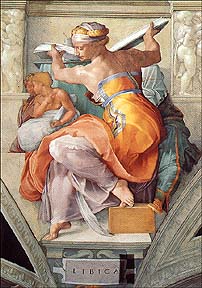|
|
|
|

Michelangelo. The Libyan Sibyl, 1512.
Sistine Chapel Ceiling, Vatican Museums.

John Lyly was born in Kent in 1554. He was brought
up in Canterbury where he likely attended the King's School at the same
time as Marlowe. Lyly received the A.M. degree
at Magdalen College, University of Oxford, in 1575. After failed petitions
for support from Lord Burghley
for a fellowship, Lyly removed to London.
He became instantly famous with the publication of
the prose romance Euphues, or the Anatomy of
Wit (1578) and its sequel Euphues
and His England (1580). Euphues is Greek for
"graceful." Euphuism, as the elaborate
prose style modelled on Lyly came to be called, was at the
height of popularity in the 1580s. Euphuistic style has two features:
an especially elaborate
sentence structure based on parallel figures from the ancient rhetorics
and a wealth of ornament including proverbs, incidents from history and
poetry, proverbs, and similes drawn from pseudoscience, from Pliny, from
textbooks, or from the author's imagination.1
Lyly's style had a marked impact on contemporary writers, not the least on
Shakespeare. Polonius in Hamlet, Moth in Love's Labour's
Lost, and the repartees of Beatrice and Benedick in Much Ado
About Nothing show signs of Lyly's influence.
In 1583, Lyly married Beatrice Browne, a Yorkshire heiress. The same year, he became
in control of the first Blackfriars Theatre.
He wrote several prose comedies for children's
companies, all geared towards the courtly audience. These plays included Campaspe
(1584), Sapho and Phao (early 1580s), Endymion:
The Man in the Moon (1586-7), Love's
Metamorphosis (1589), Midas
(1589), and Mother Bombie
(1589).2
Lyly's only play in verse was the comedy The
Woman in the Moone (1594?).
Lyly's contribution to the Martin
Marprelate controversy, on the bishops' side, was 1589's Pap
with an Hatchet. Lyly served as an MP three times, the first of
which was for Hindon in Wiltshire, in 1589. Lyly spent most of the
remainder of his life at his wife's home in Mexborough, Yorkshire.
- The Norton Anthology of English Literature, 6th ed. v1.
New York: W. W. Norton & Company, 1993. 1003.
- The
Cambridge Guide to Literature in English. Ian Ousby, Ed.
Cambridge, Cambridge University Press, 1998. 577.
Selected Bibliography:
Daniel, Carter A., ed., The
Plays of John Lyly (1988)
Lyly, John, The
Complete Works of John Lyly, 3 vols. (1902; repr. 1992)
Wilson, John Dover, John
Lyly (1905; repr. 1969).
To cite this article:
Jokinen, Anniina. "The Life of John Lyly." Luminarium.
15 Apr 2004. [Date you accessed this article].
<http://www.luminarium.org/renlit/lylybio.htm>
 | to Renaissance English Literature |
 | to Renaissance English Drama |
Site copyright ©1996-2025 Anniina Jokinen. All Rights Reserved.
Created by Anniina Jokinen on May 13, 1996. Last updated on April 19, 2025.
|
|
The Tudors
King Henry VII
Elizabeth of York
King Henry VIII
Queen Catherine of Aragon
Queen Anne Boleyn
Queen Jane Seymour
Queen Anne of Cleves
Queen Catherine Howard
Queen Katherine Parr
King Edward VI
Lady Jane Grey
Queen Mary I
Queen Elizabeth I
Renaissance English Writers
Bishop John Fisher
William Tyndale
Sir Thomas More
John Heywood
Thomas Sackville
John Bale
Nicholas Udall
John Skelton
Sir Thomas Wyatt
Henry Howard
Hugh Latimer
Thomas Cranmer
Roger Ascham
Sir Thomas Hoby
John Foxe
George Gascoigne
John Lyly
Thomas Nashe
Sir Philip Sidney
Edmund Spenser
Richard Hooker
Robert Southwell
Robert Greene
George Peele
Thomas Kyd
Edward de Vere
Christopher Marlowe
Anthony Munday
Sir Walter Ralegh
Thomas Hariot
Thomas Campion
Mary Sidney Herbert
Sir John Davies
Samuel Daniel
Michael Drayton
Fulke Greville
Emilia Lanyer
William Shakespeare
Persons of Interest
Visit Encyclopedia
Historical Events
Field of the Cloth of Gold, 1520
Pilgrimage of Grace, 1536
The Babington Plot, 1586
The Spanish Armada, 1588
Elizabethan Theatre
See section
English Renaissance Drama
Images of London:
London in the time of Henry VII. MS. Roy. 16 F. ii.
London, 1510, the earliest view in print
Map of England from Saxton's Descriptio Angliae, 1579
Location Map of Elizabethan London
Plan of the Bankside, Southwark, in Shakespeare's time
Detail of Norden's Map of the Bankside, 1593
Bull and Bear Baiting Rings from the Agas Map (1569-1590, pub. 1631)
Sketch of the Swan Theatre, c. 1596
Westminster in the Seventeenth Century, by Hollar
Visscher's Panoramic View of London, 1616. COLOR
|
|